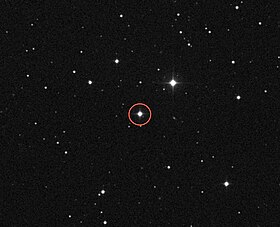Gliese 445
 Image of AC +79 3888 (circled), also known as Gliese 445, located 17.6 light-years from Earth. NASA's Voyager 1 spacecraft, which is out of our solar system, is headed toward an encounter with the star. In about 40,000 years, Voyager 1 will be closer to this star than our own sun. Credit: Caltech/Palomar |
|
| Observation data Epoch J2000.0 Equinox J2000.0 (ICRS) |
|
|---|---|
| Constellation | Camelopardalis |
| Right ascension | 11h 47m 41.3771s |
| Declination | +78° 41′ 28.178″ |
| Apparent magnitude (V) | 10.78 |
| Characteristics | |
| Spectral type | M3.5 |
| B−V color index | 1.6 |
| V−R color index | 0.8 |
| R−I color index | 0.8 |
| Astrometry | |
| Radial velocity (Rv) | −119 km/s |
| Proper motion (μ) |
RA: 743.58 mas/yr Dec.: 480.47 mas/yr |
| Parallax (π) | 185.52 ± 1.43mas |
| Distance | 17.6 ± 0.1 ly (5.39 ± 0.04 pc) |
| Details | |
| Mass | 0.15–0.30 M☉ |
| Radius | 0.320 R☉ |
| Other designations | |
| Database references | |
| SIMBAD | data |
| ARICNS | data |
Gliese 445 (Gl 445) is an M-type main sequence star in the constellation of Camelopardalis, close to Polaris. It is currently 17.6 light-years from the Sun and has an apparent magnitude of 10.8. It is visible from north of the Tropic of Cancer all night long, but not to the naked eye. Because the star is a red dwarf with a mass only a quarter to a third of that of our Sun, scientists question the ability of this system to support life. Gliese 445 is also a known X-ray source.
The Voyager 1 probe will pass within 1.6 light years of Gliese 445 in about 40,000 years. However, by that time the probe will no longer be operational. Also, given the star's inherent low brightness, even at that distance it would be barely visible to the naked eye of a hypothetical human being, with an apparent magnitude of only 5.72.
While the Voyager probe flies through space slowly closing on Gliese 445, the star is rapidly approaching the Sun. At the time the probe passes Gliese 445, the star will be about 1.059 parsecs (3.45 light-years) from the Sun, but with less than half the brightness necessary to be seen with the naked eye. But the dwarf star will still be farther away than other stars have achieved.
...
Wikipedia
